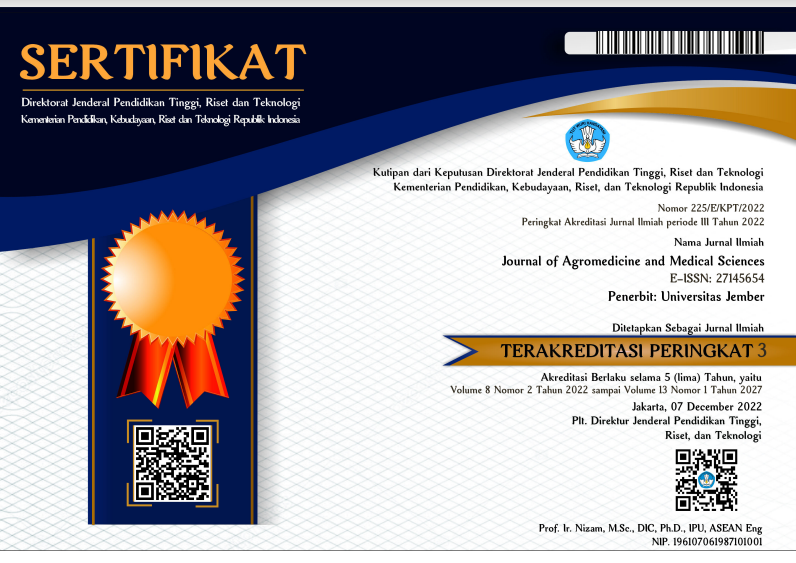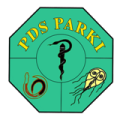Malondialdehyde Expression in HT29 Cells with Blastocystis sp. Exposure
DOI:
https://doi.org/10.19184/ams.v10i3.47044Abstract
Blastocystis sp. is one of the intestinal protozoa that is frequently found in stool specimens of colorectal cancer patients. This protozoan infection will trigger the host cell defense response to produce Reactive Oxygen Species (ROS) which causes oxidative stress. Oxidative stress can cause and aggravate colorectal cancer. Lipid peroxidation is one of the best indicators of ROS levels. Malondialdhyde is its end product so it is used as a marker of oxidative stress. This study aims to determine the exposure of Blastocystis sp. on malondialdehyde expression in colorectal cancer cell line HT29. This research is an experimental study in vitro. HT29 cells were treated with various concentrations of Blastocystis sp. antigen (0.005 μg/ml, 0.01 μg/ml, 0.05 μg/ml, 0.1 μg/ml and 0.5 μg/ml) for 72 hours. Malondialdehyde expression was examined using spectrophotometric method. Data analysis was performed using One Way Anova test. The results of the study are the mean expression of malondialdehyde in nmol/ml. The mean malondialdehyde levels of the control group, treatment with concentrations of 0.005 μg/ml, 0.01 μg/ml, 0.05 μg/ml, 0.1 μg/ml and 0.5 μg/ml were 3.134 nmol/ml, 2.682 nmol/ml, 2.556 nmol/ml, 2.744 nmol/ml, 2.84 nmol/ml and 3.286 nmol/ml respectively. The conclusion is that there is an effect of exposure to Blastocystis sp. on malondialdehyde expression of HT29 cells.
Keywords: Blastocystis sp., HT29, malondialdehyde
Downloads
References
Alief Gusnirwan Sulaiman, P. R. A. S. (n.d.). View of Malondialdehyde (MDA) as a Marker of Oxidative Stress in Various Diseases. Medical Profession Journal of Lampung Vol. 14 No. 2 (2024). https://doi.org/10.53089/medula.v14i2.990
Arfin, S., Jha, N. K., Jha, S. K., Kesari, K. K., Ruokolainen, J., Roychoudhury, S., Rathi, B., & Kumar, D. (2021). Oxidative Stress in Cancer Cell Metabolism. Antioxidants 2021, Vol. 10, Page 642, 10(5), 642. https://doi.org/10.3390/ANTIOX10050642
Aykur, M., Malatyalı, E., Demirel, F., Cömert-Koçak, B., Gentekaki, E., Tsaousis, A. D., & Dogruman-Al, F. (2024). Blastocystis: A Mysterious Member of the Gut Microbiome. Microorganisms, 12(3). https://doi.org/10.3390/MICROORGANISMS12030461
BardelÄÃková, A., Å oltys, J., & MojžiÅ¡, J. (2023). Oxidative Stress, Inflammation and Colorectal Cancer: An Overview. Antioxidants, 12(4). https://doi.org/10.3390/ANTIOX12040901
Chandramathi, S., Suresh, K., Sivanandam, S., & Kuppusamy, U. R. (2014). Stress Exacerbates Infectivity and Pathogenicity of Blastocystis hominis: In Vitro and In Vivo Evidences. PLoS ONE, 9(5). https://doi.org/10.1371/JOURNAL.PONE.0094567
Cordiano, R., Di Gioacchino, M., Mangifesta, R., Panzera, C., Gangemi, S., & Minciullo, P. L. (2023). Malondialdehyde as a Potential Oxidative Stress Marker for Allergy-Oriented Diseases: An Update. Molecules 2023, Vol. 28, Page 5979, 28(16), 5979. https://doi.org/10.3390/MOLECULES28165979
Fahmy MA, Z. S. H. M. W. A. (2019). Alteration in oxidative stress activities and trace elements levels on experimental Blastocystosis. Journal of Gastroenterology and Hepatology Research, 8(6), 3041–3048.
Fonte Galindo, L., Aleaga Santiesteban, Y., Ginori Gilke, M., Molina, Y., Hernández Barrios, Y., Santiesteban, A. Y., Gilke, G. M., & Barrios, H. Y. (2023). Blastocystosis and Urticaria: An Overview from a Syndemic Perspective. Archives of Gastroenterology Research,; Volume 4(Issue 1):36-42, Volume 4(Issue 1), 36–42. https://doi.org/10.33696/GASTROENTEROLOGY.4.046
Fujikawa, T., Fujikawa, T., Yoshimoto, Y., Kawamura, Y., Kawamoto, H., Yamamoto, T., & Tanaka, A. (2019). Alterations in Oxidative Stress Activities and Trace Elements Levels on Experimental Blastocystosis. Journal of Gastroenterology and Hepatology Research, 8(6), 3041–3048. https://doi.org/10.6051/
Gain, C., Song, S., Angtuaco, T., Satta, S., & Kelesidis, T. (2022). The role of oxidative stress in the pathogenesis of infections with coronaviruses. Frontiers in Microbiology, 13. https://doi.org/10.3389/FMICB.2022.1111930
Ghezzi, P. (2020). Environmental risk factors and their footprints in vivo – A proposal for the classification of oxidative stress biomarkers. Redox Biology, 34, 101442. https://doi.org/10.1016/J.REDOX.2020.101442
GLOBOCAN. (2020). The Global Cancer Observatory.
Hassan, M. A., Rizk, E. M., & Wassef, R. M. (2016). MODIFIED CULTURE METHODOLOGY FOR SPECIFIC DETECTION OF BLASTOCYSTIS HOMINIS IN STOOL SAMPLES. Journal of the Egyptian Society of Parasitology, 46(3), 541–548.
Kodio, A., Coulibaly, D., Koné, A. K., Konaté, S., Doumbo, S., Guindo, A., Bittar, F., Gouriet, F., Raoult, D., Thera, M. A., & Ranque, S. (2019). Blastocystis Colonization Is Associated with Increased Diversity and Altered Gut Bacterial Communities in Healthy Malian Children. Microorganisms, 7(12). https://doi.org/10.3390/MICROORGANISMS7120649
Kumarasamy, V., Atroosh, W. M., Anbazhagan, D., Abdalla, M. M. I., & Azzani, M. (2022). Association of Blastocystis hominis with colorectal cancer: A systematic review of in vitro and in vivo evidences. World Journal of Gastrointestinal Oncology, 14(3), 734. https://doi.org/10.4251/WJGO.V14.I3.734
Kumarasamy, V., Kuppusamy, U. R., Jayalakshmi, P., Samudi, C., Ragavan, N. D., & Kumar, S. (2017). Exacerbation of colon carcinogenesis by Blastocystis sp. PLoS ONE, 12(8). https://doi.org/10.1371/JOURNAL.PONE.0183097
Kunst, C., Schmid, S., Michalski, M., Tümen, D., Buttenschön, J., Müller, M., & Gülow, K. (2023). The Influence of Gut Microbiota on Oxidative Stress and the Immune System. Biomedicines 2023, Vol. 11, Page 1388, 11(5), 1388. https://doi.org/10.3390/BIOMEDICINES11051388
Lepczyńska, M., Białkowska, J., Dzika, E., Piskorz-Ogórek, K., & Korycińska, J. (2017). Blastocystis: how do specific diets and human gut microbiota affect its development and pathogenicity? European Journal of Clinical Microbiology & Infectious Diseases, 36(9), 1531. https://doi.org/10.1007/S10096-017-2965-0
Luh, N., Diarthini, P. E., Kadek Swastika, I., Ariwati, L., Isyaputri, R., Yasin Fitri N, M., Hidajati, S., & Basuki, S. (2018). BLASTOCYSTIS AND OTHER INTESTINAL PARASITES INFECTIONS IN ELEMENTARY SCHOOL CHILDREN IN DUKUH VILLAGE, KARANGASEM DISTRICT, BALI. Indonesian Journal of Tropical and Infectious Disease, 7(3), 57–61. https://doi.org/10.20473/IJTID.V7I3.7323
Öncü Öner, T., Karabey, M., Can, H., Değirmenci Döşkaya, A., Karakavuk, M., Gül, A., Köseoğlu, A. E., Döşkaya, M., Ün, C., Gürüz, A. Y., Kaya, S., Pektaş, B., & Aksoy Gökmen, A. (2022). Molecular investigation of Blastocystis sp. and its subtypes in cancer patients under chemotherapy in Aegean region, Turkey. Acta Tropica, 233, 106577. https://doi.org/10.1016/J.ACTATROPICA.2022.106577
Pawłowska, M., Mila-Kierzenkowska, C., Szczegielniak, J., & Woźniak, A. (2023). Oxidative Stress in Parasitic Diseases—Reactive Oxygen Species as Mediators of Interactions between the Host and the Parasites. Antioxidants 2024, Vol. 13, Page 38, 13(1), 38. https://doi.org/10.3390/ANTIOX13010038
Sulżyc-Bielicka, V., Kołodziejczyk, L., Adamska, M., Skotarczak, B., Jaczewska, S., Safranow, K., Bielicki, P., Kładny, J., & Bielicki, D. (2021). Colorectal cancer and Blastocystis sp. infection. Parasites and Vectors, 14(1), 1–9. https://doi.org/10.1186/S13071-021-04681-X/TABLES/5
Sylla, K., Sow, D., Lelo, S., Dieng, T., Tine, R. C., & Faye, B. (2022). Blastocystis sp. Infection: Prevalence and Clinical Aspects among Patients Attending to the Laboratory of Parasitology– Mycology of Fann University Hospital, Dakar, Senegal. Parasitologia 2022, Vol. 2, Pages 292-301, 2(4), 292–301. https://doi.org/10.3390/PARASITOLOGIA2040024
Uchiyama, J., Akiyama, M., Hase, K., Kumagai, Y., & Kim, Y. G. (2022). Gut microbiota reinforce host antioxidant capacity via the generation of reactive sulfur species. Cell Reports, 38(10), 110479–110479. https://doi.org/10.1016/J.CELREP.2022.110479
Yason, J. A., Liang, Y. R., Png, C. W., Zhang, Y., & Tan, K. S. W. (2019). Interactions between a pathogenic Blastocystis subtype and gut microbiota: In vitro and in vivo studies. Microbiome, 7(1), 1–13. https://doi.org/10.1186/S40168-019-0644-3/FIGURES/6
Zmora, P., StefanÃak, J., RudzÃ, M., & Sikorska, K. (2023). Epidemiology of Blastocystis Infection: A Review of Data from Poland in Relation to Other Reports. Pathogens 2023, Vol. 12, Page 1050, 12(8), 1050. https://doi.org/10.3390/PATHOGENS12081050
Downloads
Published
Issue
Section
License
Copyright (c) 2024 Selfi Renita Rusjdi, Nuzulia Irawati, Yanwirasti Yanwirasti, Noza Hilbertina

This work is licensed under a Creative Commons Attribution-ShareAlike 4.0 International License.























